Kanji for Disaster, Calamity, Misfortune: 災 (Wazawa-i)
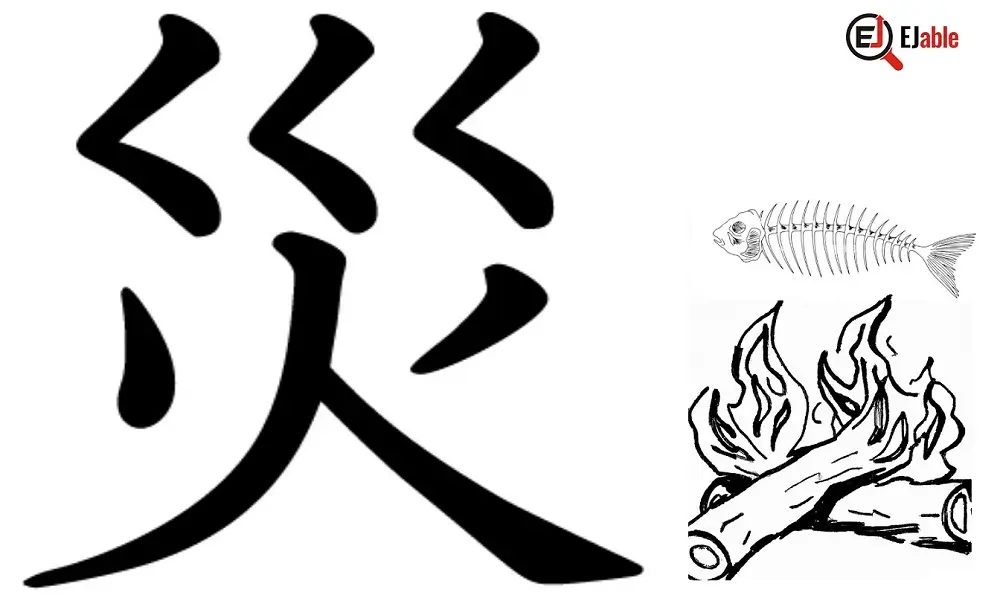
The Japanese kanji for “disaster” is 災. The Kanji 災 also means the synonyms of disaster, e.g., “calamity.”
The pronunciation of the Kanji 災 is “wazawa-i” (わざわ-い) in its kun’yomi (Japanese reading) and “sai” (さい) in its on’yomi (Chinese reading).
The Kanji 災 denoting disaster has 7 strokes and is part of JLPT N1. In Japanese schools, this Kanji is taught in grade 5.
Origin of 災 (Kanji for Disaster)
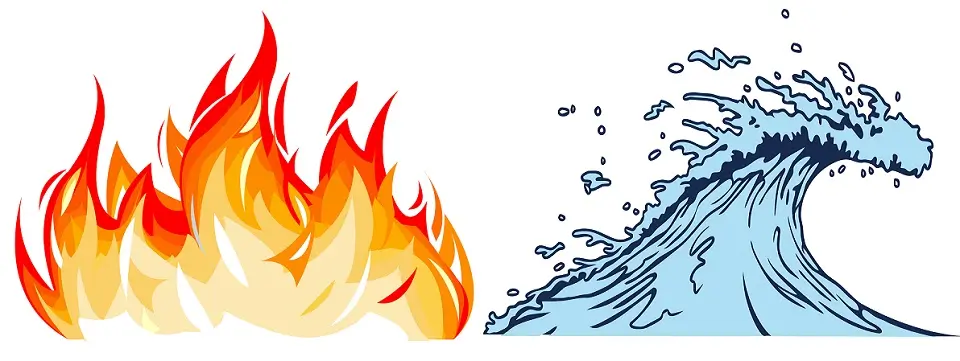
The kanji 災 has its origin in two elements of nature responsible for many natural disasters, namely Fire and Water. In case you wish to check, please read about these in the following guides:
- Kanji of Fire (火)
- Radical of the Kanji of Water (巛)
You will notice that the Kanji for disaster or calamity has the Kanji of Fire as the lower part and the radical of the Kanji of water as the upper part.
Though fire and water are essential for life, these two elements of nature also symbolize a calamity or disaster, often of natural origin, like a fire or flood. The combination of these elements evokes the destructive power of natural disasters, historically significant sources of calamity in human societies.
Mnemonic: How to Remember the Kanji 災 of Disaster
The above explanation of the origin of the shape of 災, associated with two forces of nature that cause natural disasters, is sufficient to remember this Kanji. However, you can use the following Mnemonic to remember it easily:
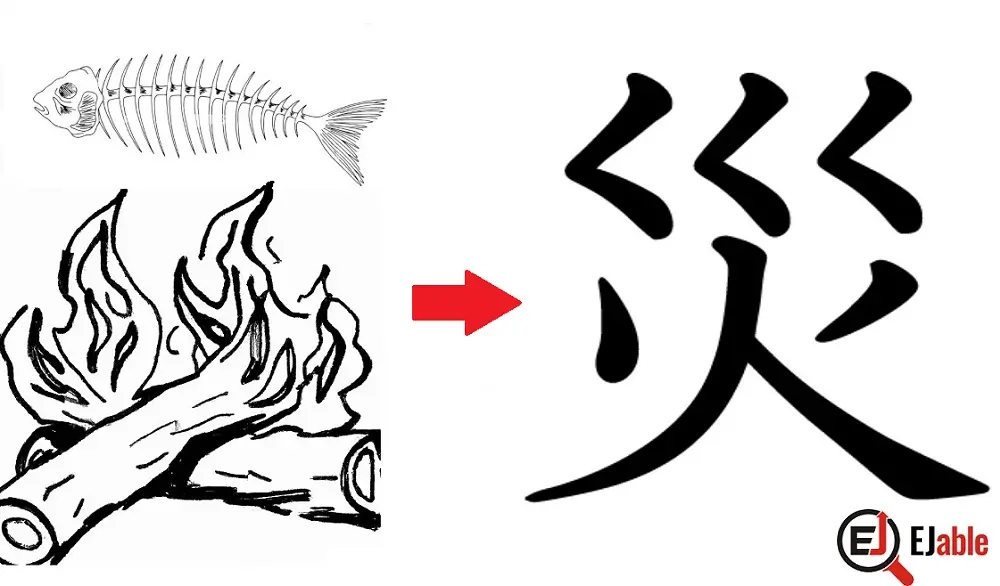
Explanation
Imagine a live fish over a fire. Certainly, it will be a “disaster” for the fish. This logic to memorize disaster Kanji will come in very handy if you imagine the shape of the skeleton of the fish above the fire.
Stroke Order for the Kanji 災
The following illustrations show the stroke order of the 7 strokes to write the Kanji 災:
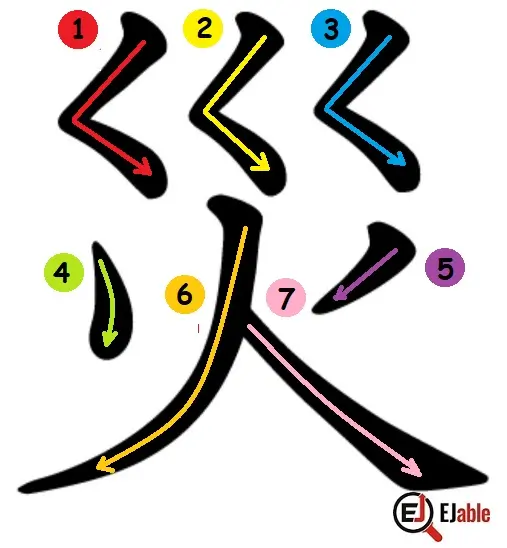
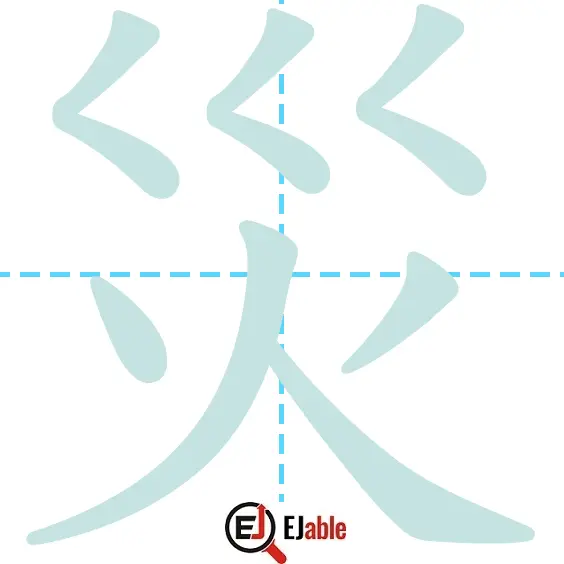
Other Meanings of 災:
While the primary meaning of 災 is related to disasters and calamities, the character is often used in compound words related to misfortune or unfortunate events. However, in most contexts, its usage remains closely tied to the idea of significant and often unexpected trouble or distress.
The kanji 災 effectively encapsulates the destructive and sudden nature of disasters, deeply rooted in the natural elements of fire and water, which are both life-sustaining and potentially devastating.
Cultural Context of The Kanji of Disaster:
In Japanese culture and history, natural disasters such as earthquakes, typhoons, and tsunamis are a recurrent part of life, 災 holds a significant place. It represents the physical manifestation of disasters and the human response to these challenging events – a mix of resilience, preparedness, and respect for nature’s power.
災’s Use in Japanese Language:
While 災 primarily denotes disasters broadly, its use extends to various compound words and expressions describing different calamities or misfortunes. There are 24 Japanese words that begin with the Kanji 災, and it appears in 104 words.
For example, check the following words using the Kanji of disaster:
- 災害 (さいがい, saigai): Disaster, calamity (Please check the difference below).
- 自然災害 (しぜんさいがい, shizen saigai): Natural disaster.
- 災難 (さいなん, sainan): Misfortune, trouble.
- 防災 (ぼうさい, bousai): Disaster prevention.
- 災害対策 (さいがいたいさく, saigai taisaku): Disaster countermeasures.
- 災害復興 (さいがいふっこう, saigai fukkou): Disaster recovery.
- 被災 (ひさい, hisai): Suffering from a disaster.
- 災厄 (さいやく, saiyaku): Calamity, misfortune.
- 災禍 (さいか, saika): Disaster, calamity.
- 核災害 (かくさいがい, kaku saigai): Nuclear disaster.
- 天災 (てんさい, tensai): Natural disaster.
- 水害 (すいがい, suigai): Flood damage.
- 地震災害 (じしんさいがい, jishin saigai): Earthquake disaster.
- 火災 (かさい, kasai): Fire disaster.
- 災害救助 (さいがいきゅうじょ, saigai kyuujo): Disaster relief.
These words often appear in the context of news reports, governmental policies, and discussions regarding public safety and emergency management, reflecting the various aspects and responses related to disasters.
Difference Between 災害 (さいがい, “saigai”) and 災 (さい, “wazawai”)
While both 災 (さい, “wazawai”) and 災害 (さいがい, “saigai”) can be translated to “disaster” or “calamity” in English, there’s a subtle difference in their usage and connotation in Japanese:
- 災 (さい, “wazawai”):
- This character alone typically refers to disasters or calamities in a more general or poetic sense.
- It’s often used in a broader, sometimes more abstract way to talk about misfortunes or calamities, not necessarily limited to large-scale natural or human-induced disasters.
- 災 may also appear in more traditional or literary contexts.
- 災害 (さいがい, “saigai”):
- This is a compound word, combining 災 (disaster) and 害 (harm, damage).
- 災害 is more commonly used in modern Japanese to specifically refer to disasters, whether natural or caused by humans, such as earthquakes, floods, or industrial accidents.
- It is a technical term and is often used in official, legal, and emergency management contexts.
- This term emphasizes the aspect of harm or damage associated with the disaster.
In summary, while both terms relate to disasters, 災害 is more specific and commonly used in formal or technical contexts, particularly when referring to the harmful impacts of such events.
Check other Kanji characters on the page “How to Learn Kanji“. You may also like to read about the common Kanji radicals.

A long-term ex-pat in Japan, Himanshu comes with an IT background in SAP consulting, IT Business Development, and then running the country operations of an IT consulting multinational. Himanshu is the co-founder and Managing Director of ReachExt K.K. and EJable.com. He is also an Advisory Board Member of a Silicon Valley AI/IoT startup.
